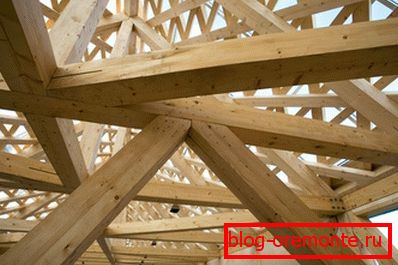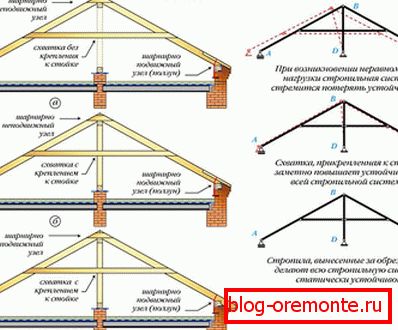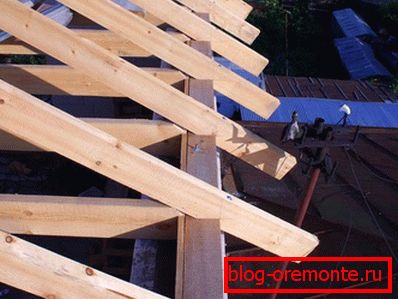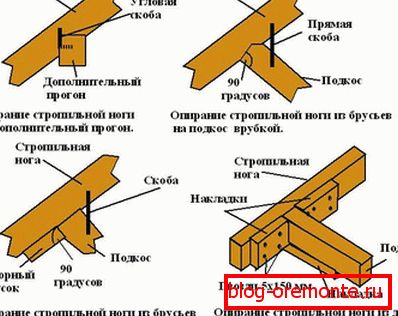How to install rafters on the roof
Designing a country house includes not only the calculation of the type and strength of the foundation, the area, height and number of floors of the building, but also the construction of the roof. When developing a project, all factors are taken into account, and the optimal variant of the system of rafters is selected that is able to decorate a building and protect it from cold and rain.
If you decide to build a house yourself, you need to know what the roof system is and how to install the rafters on the roof to get the desired result. In our article we will talk about the truss system, the rules of its installation and types of rafters.
Sling system

Whatever form of roof you choose for your home, there will always be a truss system at the heart of the roof structure. To cover the roof with roofing material, a crate and waterproofing layer are laid on the rafter system.
For the manufacture of the structure, a coniferous tree is used with a special treatment with protective agents and moisture not exceeding 2%.
Note! Wood grade 1 is needed for tightening and hanging rafters. Material 1 and 2 grades buy for rafter legs. Wood grade 3 can only be used for the manufacture of racks and struts.
The durability and strength of the truss system depends on the quality of the material, the reliability of the connections and the correctness of the design calculation. Pay special attention to rafters. Let's take a look at what the rafter consists of so that it is easier to do the assembly and installation of the entire system on the roof.

The rafter consists of the elements:
- rafter legs;
- the struts abutting against the upper part of the building wall (otherwise they are called struts);
- the racks supporting rafter legs and located vertically;
- support beams (crossbars) which serve as the basis for all load-bearing elements of the roof and are laid parallel to the base of the building between the rafters;
- in the rafters of the hanging type there are racks that work in tension along the vertical and have a name - headstock;
- for resistance to spacer forces are installed.
These are the basic elements of the rafter, but additional components are used for complex structures of rafter systems. For installation of rafters on the roof with your own hands you need to prepare materials and tools:
- waterproofing material;
- rafters;
- boards;
- fasteners;
- hammer and ax;
- nail puller, tape measure;
- electric drill with a set of drills;
- chainsaw;
- level and pencil.
When everything is ready, it is time to start building the roof, and therefore installing the rafters on the house.
Installation

Stage # 1. From boards to make a template designed truss truss. Raise two planks to the ceiling and connect their edges at one end with nails. Dissolve the boards to the side and install the free edges on the laid support beam. To fix the angle formed between the boards, nail the cross bar.
Lower the template from the boards onto the support beam and with a pencil mark the trimming angle of the rafter for durable fastening. This method allows you to quickly and easily select the correct angle of cut and installation of rafters.
Note! At this stage of the work can not be in a hurry. The better the template is made, the more reliable and stronger the whole structure will be.
Stage 2. Put the template on the ground and start making rafters. The template must be well bonded so as not to disturb the angle of connection of the rafter legs. When the first rafter (farm) is ready, it is lifted onto the building and set on the ground.

Stage 3. On rafters and mauerlate mark the place of the cut. Chainsaw make a cut for proper installation. Proceed to assembling the next truss truss.
Stage 4. The first two prefabricated trusses of the truss system should be installed on the mauerlat along the edges of the house. To determine the required level between them, pull the cord.
Обратите внимание! Установленные по краю мауэрлата стропила закрепляются подпорками с обеих сторон. Installation ферм должен быть строго перпендикулярным основанию перекрытия.

Stage number 5. The level is set, all the fixings are carefully checked and it's time to start assembling the remaining rafters. The number of farms is determined on the basis of the total length of the system and the step between the trusses of no more than 0.8 m. It is easier to assemble the structure on beams.
Note! To avoid shifting the rafters, it is best to score two boards between them.
Stage # 6. The time has come to do the installation and mounting of supports and transverse strips. In addition, it is desirable to resolve issues with waterproofing, vapor barrier and thermal insulation of the entire roofing system. For installation of roofing material crate is installed. The fastening frequency of the batten elements depends on the selected roofing material.

The type of roof depends on which angle of slope of the roof is chosen. For a flat roof, the slope angle does not exceed 10%, and for a sloping structure, the slope angle is always greater than 10%. Pitched roofs come in various designs:
- Based on two sides of a building of different levels, the roofs are called leaning.
- Based on the sides of the same level of construction are called gable.
- The four-pitched roofs are distinguished by triangular slopes. When the ramp does not reach the eaves, the roof is called half-hinged.
- Converging to one point the tops of the four triangular slopes form a hipped roof.
- Mansard truss system is also differently called broken gable, characterized by the fact that it consists of rectangular ramps connected at an obtuse angle.

Hanging and slanting rafters are used to assemble truss systems. The time has come to talk about systems consisting of hanging or nylon rafters.
Hanging

To decide how to install rafters, you need to know which type will be used when creating the truss system. The choice of mounting methods and type of rafters is influenced by many factors - the roofing coating used, the angle of inclination of the roof slopes, the expected loads from gusts of wind and snow.
Hanging rafters отличаются тем, что упираются они только на мауэрлат и при их монтаже не используются промежуточные подпорки. Такая система стропил создает сильные распирающие усилия горизонтального типа, действующие на стены здания. Чтобы снизить эти усилия, устанавливаются затяжки, одновременно выполняющие роль крепежных деталей для стропильных ног.


You can have puffs near the power plate or above. With high installation, you need a stronger connection rafters and puffs.
Обратите внимание! Installation висячих стропил возможен только тогда, когда пролет кровли не больше 12 метров.
Наклонные

Если во время строительства дома было предусмотрено возведение внутренней несущей стены, крышу дома делают из наслонных стропил. Installation наслонных стропил ничем не отличается от установки каркасной системы.
Fastening rafters can be done in different ways and it depends on the material used for the construction of the walls of the building. On the wooden framework of the tree is made connection of the rafters with the upper crown. For the frame building is used mount with top strapping. For a building of stone, the rafters are attached to the support bar.

To prevent small sections of the truss legs from sagging, racks, bolts and struts are installed according to the grid design. For the manufacture of puffs on the rafter foot wood is used only good quality. For large spans for the manufacture of screeds use from 2 to three logs of a length of 650 cm. They are aligned in one plane and fasten together with each other along the length.
For the manufacture of racks and struts using trimming logs with pre-made ottiskoy ends and pattern markup of metal sheets. Having made a preliminary marking, we saw the place for cutting the rafters into the power plate.
When constructing the upper part of the truss and walls, beams of the composite type with lamellar dowels are used. Make beams of composite type of bars, fastening them with pins of wood along the entire length.

Now you know the design of roof systems and how to install different types of rafters on the roof of buildings. To supplement the information obtained from the article with a clear example, we recommend watching a video about installing rafters.
If you have already installed the rafters yourself and you have your own secrets of installation, share with us and our readers, leaving a comment on the article.
Video
Installation of rafters can be done by one person without assistants:
In the following video, you will see errors that are often made during the installation of rafters: